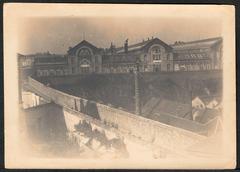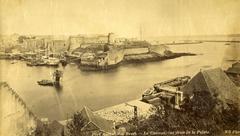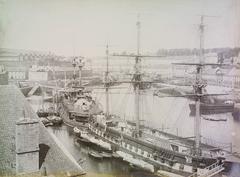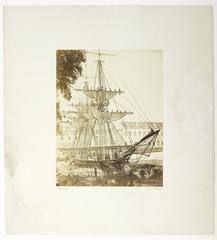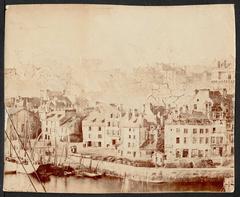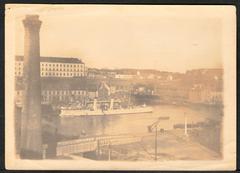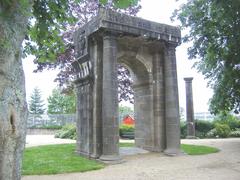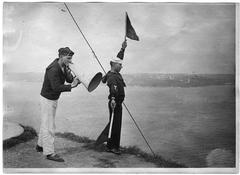
Brest Prison Visiting Hours, Tickets, and Historical Significance in Brest, France
Date: 04/07/2025
Introduction to Brest Prison and Its Historical Importance
Brest Prison, historically known as the “bagne de Brest,” is a key chapter in the intertwined maritime, military, and penal history of Brest, France. Built between 1749 and 1751 under engineer Antoine Choquet de Lindu, the prison was conceived to house convicts sentenced to forced labor, supporting the city’s vital naval infrastructure. Its location beside the Brest naval arsenal reflects the close connection between military expansion and the use of penal labor during the Ancien Régime and subsequent eras. Although the original structure was demolished in 1948, its legacy persists through preserved artifacts, museum exhibits, and surrounding historic sites that help narrate Brest’s transformation from a fortified naval port to a vibrant modern city (Musée national de la Marine, France.fr).
While the original prison site is now within an active naval base and closed to the public, visitors have several opportunities to engage with its history. The Musée National de la Marine, situated in the Château de Brest, features detailed exhibits on the prison’s role in Brest’s naval and penal systems. The Prison de Pontaniou, dating from 1810, remains visible in the Recouvrance district and is included in guided historical tours (revigorate.com, try-travel.com).
This guide explores the rich history of Brest Prison, shares practical visitor information—including museum visiting hours and ticketing—and highlights related historical sites and travel tips to help you uncover the narratives embedded in Brest’s unique heritage.
Table of Contents
- Introduction
- Origins and Construction of Brest Prison
- Life and Discipline Inside the Prison
- Security Measures and Notable Events
- Role in Naval and Urban Development
- Decline, Closure, and Legacy
- Visiting Brest Prison and Related Historical Sites
- Visiting the Prison de Pontaniou: History, Tickets, and Brest Historical Sites
- Brest Prison Visiting Hours, Tickets, and Historical Insights
- Visiting Brest, France: History, Attractions, Tickets, and Travel Tips
- Summary
- References
Origins and Construction of Brest Prison
The construction of Brest Prison began in 1749, following a royal decree by Louis XV in 1748. Designed by Antoine Choquet de Lindu, the prison centralized the management of galley prisoners, providing a large workforce for the burgeoning naval projects that defined Brest’s strategic value. Located at Lannouron, along the Penfeld River, and adjacent to key naval buildings—such as the corderie (ropewalk), barracks, and hospital—the prison’s imposing 254-meter structure was built to house up to 2,000 convicts, with numbers occasionally rising to 3,000.
The two-level, four-section design was both functional and symbolic, emphasizing the state’s commitment to security and discipline.
Life and Discipline Inside the Prison
Convicts in Brest Prison wore uniforms color-coded by sentence length and were shackled in pairs, reducing any chance of escape. Days began early with physically demanding labor, including stone transport, dry dock cleaning, and participation in major urban projects such as the Cours Dajot esplanade and the Nantes-Brest Canal. Evenings were spent sleeping on cramped wooden benches called “tollards,” with little personal space or comfort.
Despite the harsh conditions, some prisoners engaged in crafts—creating straw goods and carved coconuts, which were sold in a prison bazaar frequented by locals and travelers.
Security Measures and Notable Events
A notable security measure was the installation of a 24-pounder cannon on the prison ramparts in 1764, used to signal escapes—a practice believed to have inspired the French exclamation “Tonnerre de Brest!” While executions were rare, they were carried out for severe offenses. The prison’s notoriety was further heightened by the legendary escape of Eugène-François Vidocq, who later became a famous Paris police chief.
Role in Naval and Urban Development
Brest Prison’s forced labor force was essential to the creation and maintenance of the city’s naval infrastructure and urban growth. Convicts contributed to fortifications, public spaces, and the overall expansion of Brest as a naval stronghold.
Decline, Closure, and Legacy
By the mid-19th century, changes in penal policy and the decline of forced labor led to the prison’s closure in 1858. Remaining inmates were transferred to overseas penal colonies. Surviving World War II bombings, the prison was ultimately demolished in 1948. Today, its legacy is preserved through museum artifacts and historical records at the Musée national de la Marine.
Visiting Brest Prison and Related Historical Sites
Brest Prison Visiting Hours and Tickets
The original Brest Prison no longer exists and is not open for visits. To explore its story, head to the Musée national de la Marine at the Château de Brest. The museum is open daily except Tuesdays, from 10:00 AM to 6:00 PM. Tickets range from €5 to €8 for adults, with discounts for students and seniors; check the official museum website for up-to-date details.
Guided Tours and Nearby Attractions
Guided tours of the Château de Brest often include sections on the prison and naval history. The Prison de Pontaniou (1810), while generally closed to the public, can be viewed from the outside and is included in some guided walking tours. Stroll along Rue Saint-Malo—a rare surviving 17th-century street—and enjoy panoramic city and harbor views from the Cours Dajot esplanade.
Travel Tips and Accessibility
Brest is accessible by train, bus, and air. The museum and many city attractions offer wheelchair accessibility; audio guides are available for enhanced experiences. Photography is permitted in most museum areas, but restrictions may apply in certain exhibits.
Visuals and Interactive Elements
Explore virtual tours and image galleries of the Musée national de la Marine online. High-quality photos of the prison artifacts, the Château de Brest, and the city’s historic naval architecture are available to enrich your experience.
Visiting the Prison de Pontaniou: History, Tickets, and Brest Historical Sites
Origins and Architectural Evolution
The Prison de Pontaniou, established in 1670 during the reign of Louis XIV, was integral to Brest’s emergence as a dominant naval base (revigorate.com). Its robust, imposing architecture was both functional and symbolic, designed to prevent escapes and assert state authority. Modifications over the centuries accommodated evolving penal practices and a growing inmate population.
Role in Naval and Penal History
Closely linked with Brest’s naval operations, the Prison de Pontaniou housed convicts sentenced to forced labor in the nearby shipyards, a system emblematic of French penal policy in the 18th and 19th centuries (musee-marine.fr). The prison’s population swelled during the Napoleonic Wars, holding political prisoners and foreign captives.
Social and Cultural Impact
The prison’s daily transfer of convicts to the shipyards shaped Brest’s social landscape. Once noted for relatively good conditions, the prison’s reputation declined over time due to overcrowding and deteriorating facilities (revigorate.com). Its closure in 1990 marked the end of an era, but its presence endures as a symbol of hardship and resilience.
Wartime Significance and Transformation
During World War II, the Prison de Pontaniou survived heavy bombardment and was used by occupying forces, later serving as a detention center for resistance fighters and collaborators (guide.en-vols.com).
Symbolism and Heritage Preservation
Today, the prison is featured in guided tours and educational programs, alongside nearby sites such as Rue Saint-Malo and the Lavoir de Pontaniou (trip2france.com), symbolizing Brest’s maritime and penal history.
Visitor Information
- Visiting Hours and Tickets: The interior is not open to the public. The exterior is viewable year-round, included in several guided walking tours; booking in advance is recommended.
- Accessibility: The exterior is accessible to all, though tour routes may vary in accessibility. Check details with providers.
- Guided Tours and Events: Several local tours include the prison as a highlight, often paired with other naval and historical sites.
- Photographic Spots: Rue Saint-Malo offers excellent views of the prison’s façade and nearby historic landmarks.
Comparative Context within French Penal History
The Prison de Pontaniou is part of a network of French prisons tied to naval arsenals and forced labor, alongside institutions like Toulon and Rochefort (musee-marine.fr).
Contemporary Relevance and Future Prospects
Since its closure, the future of the Prison de Pontaniou has been subject to debate, with preservationists advocating for its transformation into a cultural or educational center.
Brest Prison Visiting Hours, Tickets, and Historical Insights
Historical Background and Significance
Brest Prison, or “Prison de Brest,” played a pivotal role in France’s maritime and penal systems. At its peak, it housed thousands of convicts, many forced to labor on naval construction. The prison is mentioned in literature, notably Victor Hugo’s “Les Misérables,” and is symbolic of the harsh penal policies of its era (France.fr, placesandthingstodo.com).
Location and Site Features
The prison stood near the Brest Arsenal, close to other landmarks like the Château de Brest and Tanguy Tower (try-travel.com). While much of the original structure is gone, sections of walls and foundations remain as reminders of its history.
Accessibility and Visiting Hours
As of July 2025, the prison site lies within the operational Brest Naval Base and is not accessible to the public (placesandthingstodo.com). Occasionally, guided tours during special events such as European Heritage Days may include access or historical information about the prison.
Tickets and Booking
Tickets for special event tours must be booked in advance through the Brest Tourist Office or event organizers (France.fr). Prices vary by event and tour provider.
Interpretive Resources and Museums
The Musée National de la Marine in the Château de Brest is the main resource for learning about the prison’s history. The Tanguy Tower Museum also provides context on Brest’s penal and naval development (try-travel.com).
Practical Tips for Visitors
- Plan for Special Events: Time your visit with heritage events for possible access to restricted areas (placesandthingstodo.com).
- Museum Visits: Prioritize the Musée National de la Marine and Tanguy Tower Museum for historical context.
- Guided Tours: Contact the Brest Tourist Office (France.fr) for updates on guided tours, especially those in English if needed.
- Accessibility: While the area is generally accessible, some areas may be restricted or uneven; check with the tourist office ahead of your visit.
Nearby Attractions
- Château de Brest: The National Maritime Museum, with panoramic harbor views (placesandthingstodo.com).
- Tanguy Tower: Historical museum with exhibits on Brest’s development.
- Les Capucins: Cultural center in a former military workshop (placesandthingstodo.com).
- Oceanopolis: Major aquarium and marine science center (try-travel.com).
FAQs
- Can I visit Brest Prison today?
No, direct access is restricted. Exhibits and guided tours during certain events may provide historical insights. - What are Brest Prison visiting hours?
No regular hours; access only via special event tours. - Are there tickets for tours?
Yes, through the Brest Tourist Office or event organizers. - Is the site accessible for those with disabilities?
Some areas are accessible; always check with tour providers. - Where can I learn more?
The Musée National de la Marine and Tanguy Tower Museum are recommended.
Visiting Brest, France: History, Attractions, Tickets, and Travel Tips
Maritime Heritage and Naval Significance
Brest’s identity as a major naval port is visible in its fortifications, museums, and active shipyards. The Castle of Brest houses the National Naval Museum and is open Tuesday to Sunday, 10:00 AM–6:00 PM, with tickets around €6 for adults.
Cultural and Urban Attractions
Brest’s postwar reconstruction created a unique urban landscape. Les Ateliers des Capucins is now a major cultural hub, accessible by a panoramic cable car.
Natural Beauty and Outdoor Activities
Brest’s mild climate, parks, and proximity to the ocean offer excellent opportunities for walks, cycling, sailing, and visits to Océanopolis, open daily with tickets around €20.
Culinary Traditions
Enjoy Brittany’s seafood, crêpes, and cider at local markets such as Marché Saint-Louis and in harbor-side restaurants.
Accessibility and Getting Around
Brest is served by rail, road, air, and public transport (Bibus). Many attractions are accessible for visitors with disabilities.
Safety
Brest is considered safe and welcoming, with standard advice for urban travel applying.
FAQ
- Castle of Brest hours? Tuesday–Sunday, 10:00 AM–6:00 PM.
- Océanopolis ticket price? Around €20 for adults.
- Best time to visit? May–September.
- Accessibility? Most public venues and transport are accessible.
- Getting around? Buses, trams, bikes, taxis, and car rentals are available.
Plan your trip via the Brest Tourism Office website and download the Audiala app for guided audio tours.
Summary
Brest Prison’s history reflects the intersection of maritime ambition and penal policy in France. Though the physical prison is gone, its legacy is preserved in museums, city landmarks, and collective memory (Musée national de la Marine, revigorate.com). The Prison de Pontaniou and the Musée National de la Marine offer deep insights into this legacy. Travelers are encouraged to plan around heritage events, utilize guided tours, and explore digital resources such as virtual museum tours and the Audiala app for a meaningful visit. Brest’s blend of history, culture, and maritime tradition awaits discovery.
References and Further Reading
- Musée national de la Marine: Brest Prison Collection
- Wikipedia: Brest Prison
- The Crazy Tourist: Best Things to Do in Brest
- KilRoyTrip: Prison Pontaniou
- Visite.fr: Brest Prison de Pontaniou
- revigorate.com: Things to Do in Brest
- guide.en-vols.com: Brest Destination Guide
- trip2france.com: Things to Do in Brest
- France.fr: Brest Brittany
- placesandthingstodo.com: Brest Sightseeings
- try-travel.com: Things to Do in Brest




































